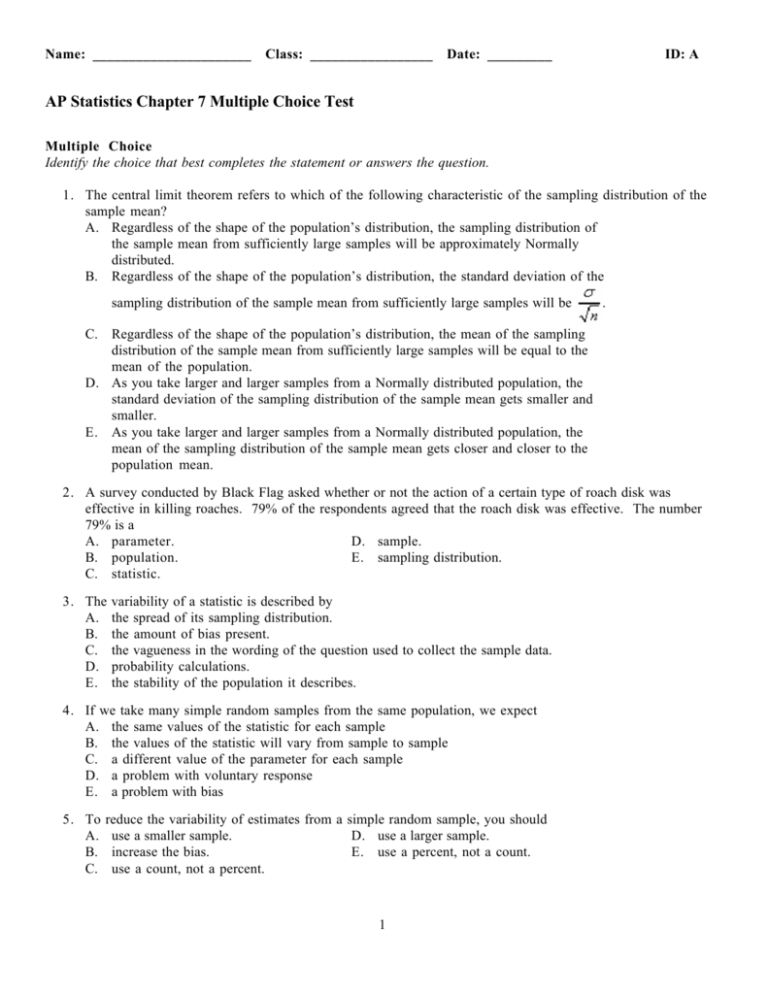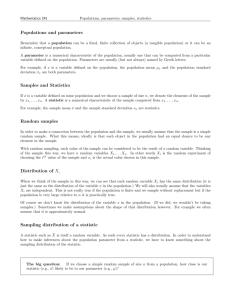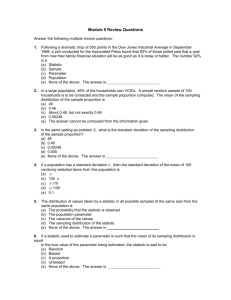AP Statistics Chapter 7 Multiple Choice Test
advertisement

Name: ______________________ Class: _________________ Date: _________ ID: A AP Statistics Chapter 7 Multiple Choice Test Multiple Choice Identify the choice that best completes the statement or answers the question. 1. The central limit theorem refers to which of the following characteristic of the sampling distribution of the sample mean? A. Regardless of the shape of the population’s distribution, the sampling distribution of the sample mean from sufficiently large samples will be approximately Normally distributed. B. Regardless of the shape of the population’s distribution, the standard deviation of the sampling distribution of the sample mean from sufficiently large samples will be . C. Regardless of the shape of the population’s distribution, the mean of the sampling distribution of the sample mean from sufficiently large samples will be equal to the mean of the population. D. As you take larger and larger samples from a Normally distributed population, the standard deviation of the sampling distribution of the sample mean gets smaller and smaller. E. As you take larger and larger samples from a Normally distributed population, the mean of the sampling distribution of the sample mean gets closer and closer to the population mean. 2. A survey conducted by Black Flag asked whether or not the action of a certain type of roach disk was effective in killing roaches. 79% of the respondents agreed that the roach disk was effective. The number 79% is a A. parameter. D. sample. B. population. E. sampling distribution. C. statistic. 3. The A. B. C. D. E. variability of a statistic is described by the spread of its sampling distribution. the amount of bias present. the vagueness in the wording of the question used to collect the sample data. probability calculations. the stability of the population it describes. 4. If we take many simple random samples from the same population, we expect A. the same values of the statistic for each sample B. the values of the statistic will vary from sample to sample C. a different value of the parameter for each sample D. a problem with voluntary response E. a problem with bias 5. To A. B. C. reduce the variability of estimates from a simple random sample, you should use a smaller sample. D. use a larger sample. increase the bias. E. use a percent, not a count. use a count, not a percent. 1 Name: ______________________ ID: A 6. Following a dramatic drop of 500 points in the Dow Jones Industrial Average in September 1998, a poll conducted for the Associated Press found that 92% of those polled said that a year from now their family financial situation will be as good as it is today or better. Which of the following terms describes the number 92%? A. statistic. D. population parameter. B. sample. E. population. C. sample parameter. 7. What is distribution of values taken by a statistic in all possible samples of the same size from the same population called? A. the probability that the statistic is obtained. B. the population parameter. C. the variance of the values. D. the sampling distribution of the statistic. E. the distribution of sample data. 8. Suppose you take a random sample of size 25 from a population with mean of 120 and a standard deviation of 15. Your sample has a mean of 115 and a standard deviation of 13.8. Which of the following has a mean of 120 and a standard deviation of 3? A. the distribution of the population B. the distribution of the sample data. C. the sampling distribution of the sample mean. D. the sampling distribution of the population mean. E. No important distribution related to this situation has the given mean and standard deviation. 9. In order to use the formula to calculate the standard deviation of the sampling distribution of the sample mean, which of the following conditions must be met? I. II. The population’s distribution is approximately Normal. III. The sample size is less than 10% of the population size. A. I only B. II only C. III only D. III and either I or II E. All three conditions must be met. 10. Which of the following distributions has a mean that varies from sample to sample? I. The population distribution II. The distribution of sample data III. The sampling distribution A. I only D. II and III B. II only E. all three distributions C. III only 2 Name: ______________________ ID: A 11. Suppose that in a random sample of size 100, the standard deviation of the sampling distribution of the sample proportion is 0.08. If a researcher wanted to reduce the standard deviation to 0.04, what sample size would be required? A. 100 B. 200 C. 400 D. 800 E. 1600 12. A simple random sample of 1000 Americans found that 62% were satisfied with the service provided by the dealer from which they bought their car. A simple random sample of 1000 Canadians found that 59% were satisfied with the service provided by the dealer from which they bought their car. The sampling variability associated with these statistics is A. exactly the same. B. not exactly the same, but very close. C. much smaller for the sample of Canadians because the population of Canada is much smaller than that of the United States, hence the sample is a larger proportion of the population. D. smaller for the sample of Canadians because the percent satisfied was smaller than that for the Americans. E. larger for the Canadians because Canadian citizens are more widely dispersed throughout the country than are citizens in the United States, hence they have more variable views. 13. In a large population, 46% of the households own DVD recorders. A simple random sample of 100 households from this population is to be contacted and the sample proportion computed. Which of the following expressions represents the probability that more than half the households sampled will own a DVD recorder? A. D. B. E. C. 14. A statistic is said to be unbiased if A. the survey used to obtain the statistic was designed so as to avoid even the hint of racial or sexual prejudice. B. the mean of its sampling distribution is equal to the true value of the parameter being estimated. C. both the person who calculated the statistic and the subjects whose responses make up the statistic were truthful. D. the value from any sample is equal to the parameter being estimated. E. it is used for honest purposes only. 3 Name: ______________________ ID: A 15. The chipmunk population in a certain area is known to have a mean weight of 84 gm and a standard deviation of 18 gm. A wildlife biologist weighs 9 chipmunks that have been caught in live traps before releasing them. Which of the following best describes what we know about the sampling distribution of means for the biologist’s sample? A. distribution approximately Normal B. shape of distribution unknown C. distribution approximately Normal D. unknown; distribution approximately Normal E. unknown; shape of distribution unknown 16. A census of the labor force in a large metropolitan area found that the time it takes for people to commute to work has a mean of 20.5 minutes and a standard deviation of 15.4 minutes. What is the probability that a random sample of 40 people have a mean commute time that is greater than 25 minutes? A. C. B. D. E. 17. Which of the following is not a random variable? A. The number of heads in ten tosses of a fair coin. B. The number of passengers in cars passing though a toll booth. C. The age of the driver in cars passing through a toll booth. D. The response of randomly-selected people to the question, “Did you eat breakfast this morning?” E. The response of randomly-selected people to the question, “How many hours of sleep did you get last night?’ Scenario 6-3 In a population of students, the number of calculators a student owns is a random variable X described by the following probability distribution: X P(X) 18. Use A. B. C. 0 0.2 1 0.6 2 0.2 Scenario 6-3. Which of the following is the mean of X? 0.5 D. 2 1 E. Need more information. 1.2 4 Name: ______________________ ID: A 19. Use Scenario 6-3. Which of the following is the standard deviation of X? A. 1 C. 0.4472 E. Cannot be computed. B. 0.6325 D. 0.4 20. The mp3 music files on Sharon’s computer have a mean size of 4.0 megabytes and a standard deviation of 1.8 megabytes. She wants to create a mix of 10 of the songs for a friend. Let the random variable T = the total size (in megabytes) for 10 randomly selected songs from Sharon’s computer. What is the expected value of T? A. 4.0 B. 7.2 C. 10.0 D. 40.0 E. 180.0 21. What is the standard deviation of T? (Assume the lengths of songs are independent.) A. 1.80 B. 3.24 C. 5.69 D. 18.00 E. 32.40 22. There are twenty multiple-choice questions on an exam, each having responses a, b, c, or d. Each question is worth five points and only one option per question is correct. Suppose the student guesses the answer to each question, and the guesses from question to question are independent. The distribution of X = the number of questions the student will get correct, is A. binomial, n = 5, and p = 0.2. D. binomial, n = 4 and p = 0.25. B. binomial, n = 20, and p = 0.25. E. none of these. C. binomial, n = 5 and p = 0.25. 23. Using the same scneario as the last question, which of the following expresses the probability that the student gets no questions correct? A. C. B. D. E. 24. A poll shows that 60% of the adults in a large town are registered Democrats. A newspaper reporter wants to interview a local democrat regarding a recent decision by the City Council. On average, how many people will the reporter have to stop before he finds his first Democrat? A. 1 B. 1.33 C. 1.67 D. 2 E. 2.33 25. Using the same scenario as the last question, if the reporter asks adults on the street at random, what is the probability that he will find a Democrat by the time he has stopped three people? A. 0.936 B. 0.216 C. 0.144 D. 0.096 E. 0.064 5









